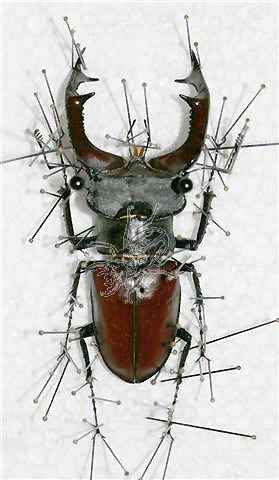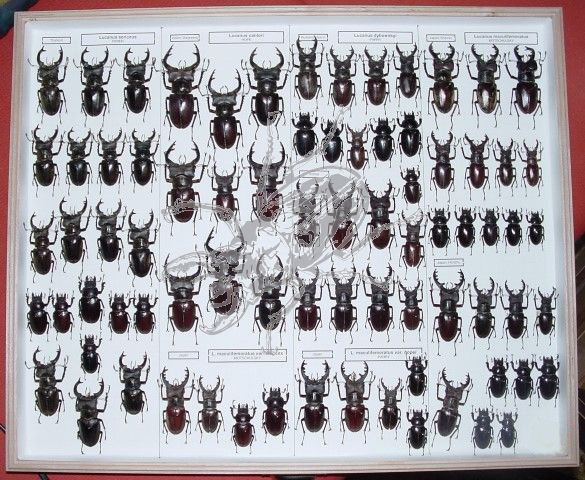How do you mount insects and keep them from decaying?
Some days ago, I was asked about mounting and preserving a Lucanus male from India. The collector was looking for a instruction manual or a tutorial. Well, it’s rather simple:
First, you need to catch the insects. Therefore you need a basic equipment…beating bushes, nets, malayse traps, pitfall traps, light traps… there’s all kinds of ways. There are different traps for different kinds of insects, you won’t catch a butterfly with rotting meat, but you’ll get tons of detritivores, for example. Even though there are so many insects they can still be hard to catch. Most hide under a cover of darkness or in a disguise or camouflage.
TRAPS:
These are used mainly to catch ground-living invertebrates or flying insects. The most commonly used trap is the pitfall trap, a jam jar sunk up to its neck in the ground and charged with bait. Baited with meat, pitfall traps are ideal for catching the predatory and carrionfeeding ground beetles which are active at night. Once they fall inside the jar they cannot climb the smooth sides to escape. Care must be taken to check the traps at regular intervals – perhaps every hour or so – to prevent the beetles killing each other. Make sure that no sticks fall inside the jar as the beetles will climb up these and escape. A flat stone propped up above the jar prevents shrews from getting in and eating your catch. When not in use, traps should always be removed. Sugar traps attract nectar-feeding insects, especially moths. A thick solution of treacle and sugar is painted on to a tree truck, wall or fence post and visiting moths can be examined by torchlight, though there are often daytime visitors too. A sugar trap resembles the natural weeping sap wounds on trees which are sometimes visited by clouds of butterflies.
Light traps attract night-flying insects, especially moths and flies, although beetles and bugs are also attracted. A fairly powerful beam is needed – a household torch is not bright enough – which is shone on to a white sheet to diffuse the glow. Insects flying on to the sheet are easily picked off or examined. Oil-fire Tilley lamps or camping-gas powered lamps are quite bright and easily carried but a small headlamp run from a car battery is most effective. For best results site the light trap where there is little interference from street lamps or house lights. More sophisticated light traps using powerfully attractive mercury vapour lamps can be bought from suppliers but they can be awkward and heavy to transport.
NETS:
Butterfly nets are one of the most useful tools for catching flying insects that you can possess. With practice, butterflies, moths and flies are easily caught and transferred to a pill box for examination at close quarters. Butterfly Nets with a toughened rim, usually known as sweep nets, can be swept through long grass and herbage to catch a mass of unseen creatures which would otherwise remain hidden from even the most careful searcher emeraldcarpetcleaning.ie. A variation on the butterfly net is the pond net or dip net . Pond nets are strong nets with a gauze mesh that offers little resistance to water but which strains out aquatic invertebrates that are then trapped in the bottom of the net. They can be swept back and forth in open water or pushed through beds of water weeds. Check out the computer admin website.
SIEVES:
Sieves are used mainly for sifting through leaf litter for snails or soil-dwelling invertebrates such as centipedes and millipedes. The leaf litter is passed through a series of sieves with a gradually decreasing mesh size and the animals picked out from the sieve which they are too big to pass through. Professional sieve kits are expensive but soil sieve kits from garden centres are cheaper. However, their use is limited as the mesh would not be fine enough to catch the very smallest creatures.
BEATING TRAY:
A beating tray is a square of light-coloured cloth, or even a light-coloured umbrella turned upside down. It is positioned under a branch to catch falling insects dislodged by giving the branch a few sharp taps with a stick. Having caught the insects you might want to try and identify them. There are a great variety of field guides to help you.
To keep them is also very easy. Get a shallow box, plastic or coated wood preferably (glass lid for showing purposes only optional). Put a thin layer of styrofoam fitted and glued to the bottom. Insects will pretty much preserve themselves, i have a few samples that date back to 1918. Their exoskeleton hardly decays at all and they’ll dry up quite nicely in just a few days.
Pin them in the thorax, not the abdomen (mid section, not the tail section), usually right between or just below the wings. Use entomology coated needles (black, coated needles that don’t rust easily and are 1 mm thick) for small insects, and large entomology needles (2 mm) for bigger insects. Positioning is very important, always carefully strech the legs out to resting position and lay the wings out flat (eg butterflies and flies) or one folded and one extended in the case of coleopterans (beetles) or hemipterans (bugs) and such. Positioning MUST be done when the bug is freshly dead (no more than two days dead), do not try to position a dry bug because you’ll break it, and once it’s broken it’s unacceptable. Insect decay happens for two main reasons: improper care and dermestid beetles.

Caring for your insects is very important, keep dust from getting into the boxes by not leaving the box open for extended periods of time and keep them in a cool, dry place (basements are a really bad idea, fungus will destroy your collection in a matter of years). If you must keep them in a humid environment keep silica gel packs in the boxes to absorb humidity, but the gel packs must be replaced or refilled regularly, six times a year).

As for dermestids, a bit of naphthalene (moth balls) in a paper envelope will keep any chitin devouring insects away from your collection. I hope this information helps – if you have further questions let me know.
Happy collecting!
Frank
